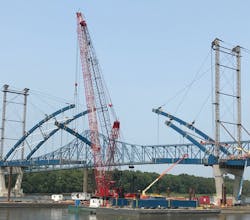Barge-mounted crane assists completion of bridge rebuild over Mississippi River
A stretch of U.S. Highway 52 is getting a new bridge to span the Mississippi River between Savanna, Ill., and Sabula, Iowa. The existing truss bridge was built back in 1932, nearly a decade before the country got involved in World War II, and has exceeded its useful life. It will be replaced with a new tied-arch structure located just 100 ft downstream.
Contractors knew there would be construction challenges, particularly involving the 500-ft central span. A barge-mounted crane would be necessary to access the lifts.
Dawes Rigging & Crane Rental, a member of the ALL Family of Companies, was brought on to the project by Kraemer North America. Dawes experts recommended the Manitowoc MLC300 crawler crane. It is uniquely qualified to accommodate the constriction of a barge, while not skimping on capacity or reach. The MLC300’s exclusive Variable Position Counterweight (VPC) automatically adjusts its counterweight, providing greater stability for each lift.
The pick weight and lift radius requirements meant the MLC300 also needed the optional VPC-MAX heavy lift attachment. This increases capacity and allows more boom and jib length combinations. It was this configuration that lifted 69-ton arch rib sections to a height of 165 ft using 295 ft of main boom, all from a barge that was sized just 70 ft x 195 ft.
Typical crawlers are heel-heavy during assembly, when no load is on the hook. During a lift, the high ground-bearing pressure transfers to the toe of the crawler. VPC technology centers the counterweight between the fully retracted and fully extended boom positions, and a patented rail system transfers the counterweight from back to front (heel to toe), depending on the boom’s extension.
“Because it moves the counterweight as needed, VPC dramatically improves stability with a more constant center of gravity,” said Ryan Harrison, Dawes’ Madison, Wis., branch manager. “This technology also eliminates the need for carbody counterweights, weight that can now be added to the upperworks to increase the crane’s capacity.”
The movable counterweight system also reduces the crane’s operating footprint, meaning it fits comfortably in smaller spaces like a barge and doesn’t, literally, rock the boat while doing its job. Less total counterweight also means fewer loads to transport the machine to the jobsite.
Dawes’ customer, Kraemer North America, could not believe how well the crane operated. “Because it’s always finding a new center of gravity, the MLC300 helped us achieve almost zero list while working on the barge,” said Patrick Shea, project manager for Kraemer. “The MLC300 has a much smaller footprint on the barge as opposed to a ringer that it replaces, saving valuable space on the barge.” he added. Shea says the barge never registered more than one degree of list.
When completed, the new bridge will be nearly 2,500 ft long, with 12-ft lanes and 8-ft shoulders, which are wider than the existing 20-ft-wide bridge. It is expected to be open to traffic by November 2017.
